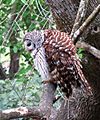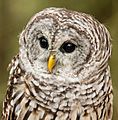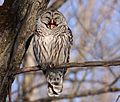Barred owl facts for kids
Quick facts for kids Barred owl |
|
|---|---|
 |
|
| Conservation status | |
| Scientific classification | |
| Kingdom: | |
| Phylum: | |
| Class: | |
| Order: | |
| Family: | |
| Genus: |
Strix
|
| Binomial name | |
| Strix varia Barton, 1799
|
|
The barred owl is a big owl that lives in the eastern parts of North America. It's known for its unique hooting calls, which often sound like "Who cooks for you? Who cooks for you all?"
Contents
About Barred Owls
Barred owls are quite large. They can grow to be about 43 to 61 centimeters (17 to 21 inches) tall. Their wingspan can reach 102 to 127 centimeters (40 to 50 inches). This is like the length of a small car!
Male barred owls usually weigh about 630 grams (22 ounces). Females are a bit heavier, weighing around 800 grams (28 ounces).
Unlike most owls in the eastern United States, barred owls have dark brown eyes. Other owls often have yellow eyes. In the wild, these owls usually live for about 10 to 12 years.
Where Barred Owls Live
Barred owls make their homes in forests. You can find them across the eastern United States, southern Canada, and even Alaska.
Sometimes, during the winter, some barred owls will migrate south. They might travel all the way to Central America.
The great horned owl is the main predator of the barred owl. This means great horned owls are the biggest danger to them.
How Barred Owls Reproduce
Barred owls build their nests on strong tree branches. They often choose spots close to ponds or lakes. This helps them find food and water easily.
They sometimes use nests that other animals have left behind. A female barred owl can lay between 1 to 5 eggs at a time.
The eggs hatch after about 28 days. The young owls, called owlets, start to fly about 42 days after they hatch.
What Barred Owls Eat
Barred owls are good hunters. They eat many different small animals. Their diet includes rabbits, squirrels, bats, snakes, and small insects.
They are also very good at catching fish. Barred owls have an amazing sense of hearing. This helps them find food from far away, even in the dark.
Images for kids
-
Although previously considered a subspecies of barred owl, the fulvous owl is now considered a distinct species.
-
Barred owl during winter in Vermont.
-
A juvenile barred owl peers out in the verdant forests of Washington, where the species is an "invasive" recent invader.
-
A 1908 photo of a site found with a massive amount of barred owl casts and pellets near Carlisle, Pennsylvania.
-
Studies have determined that hermit thrush cannot nest successfully in close proximity to barred owls due to their predatory pressure.
-
Frogs such as wood frogs are a regular prey source for barred owls.
-
Great horned owls are the most severe competitor and predator of barred owls.
-
Barred owl skeleton (Museum of Osteology)
See also
 In Spanish: Cárabo norteamericano para niños
In Spanish: Cárabo norteamericano para niños
























